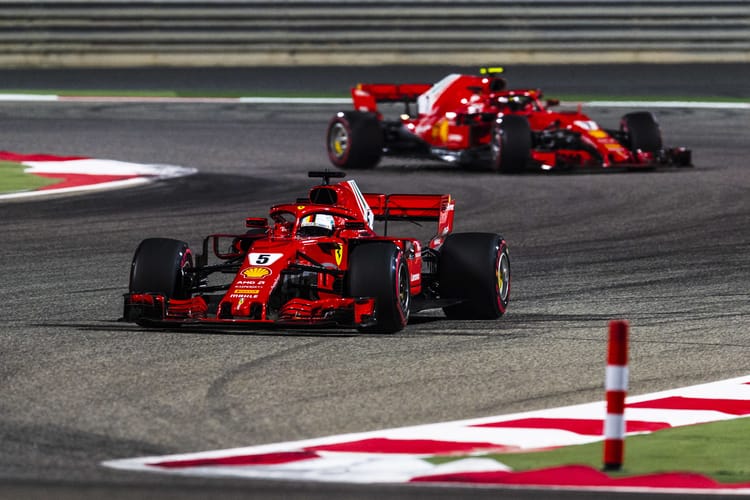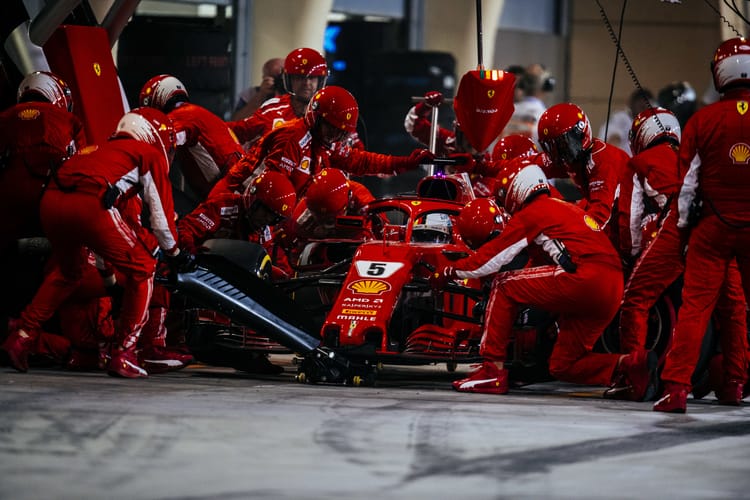It’s perhaps ironic that two days after Liberty Media, fronted by F1 mastermind Ross Brawn, laid down their proposal for an improved Formula 1, we fans were treated to a thrilling 2018 Bahrain Grand Prix, begging the question, what needs changing?
Following a lacklustre opening race to 2018, there were fresh calls for the sport’s owners to make changes. In Australia we witnessed just five overtakes; in Bahrain there were forty-two in the opening ten laps alone, including a memorable three-in-one move by Lewis Hamilton.
Not until the final moment did we know for sure that Sebastian Vettel would claim a narrow victory, while the mid-field piranha pit proved feistier than ever. Pirelli‘s tyres allowed for a mix of strategies — indeed, the top eight drivers all ran to different plans that converged at the very end to create fine margins throughout.
And of course, in the year of the much lambasted Halo and arguments over diluted risk, Formula 1 showed that it’s still a dangerous place to be.
VETTEL WINS AGAIN…JUST
It’s a clichéd comparison but the battle for victory in Bahrain played out like a chess match. And for a time, it appeared that Mercedes AMG Petronas Motorsport and Valtteri Bottas had played a bold and calculated check-mate.
Mercedes’ qualifying pace appeared to evaporate in the desert heat of Bahrain. The six-tenths-of-a-second advantage that Hamilton enjoyed in Australia had gone and Scuderia Ferrari locked out the front row for only the third time this decade.

Credit: Scuderia Ferrari
Hamilton’s grid penalty for a change of cog-swapper saw him start ninth and so Mercedes’ early-race hopes rested on the shoulders of Bottas. By jumping Kimi Raikkonen at the start, the first move had been made in the fifty-seven lap chess match with Vettel.
The abrasive nature of the Bahrain International Circuit and the rate of degradation offered by Pirelli’s rubber meant that the ideal strategy was somewhere between making one pit-stop and two. With Hamilton recovering from ninth, it was always likely that Mercedes would swap the Brit onto Pirelli’s hardest compound on offer, the white-walled mediums, and see Hamilton stretch them until the end of the race.
But at the head of the field, a two-stop strategy seemed the smartest choice. Indeed, with Pirelli stating that the Soft tyres would last a maximum of thirty laps, when Vettel stopped on lap eighteen for the yellow striped rubber, it seemed certain that the race leader would be stopping again.
But Bottas would play his check-mate move two laps later when he donned the harder, longer lasting Mediums. To win then, Vettel would have to stretch his lead to around twenty-five seconds in order to gain a ‘free’ pit-stop or do the unthinkable: make the Soft tyres last a mammoth thirty-nine laps, all while driving quick enough to fend off the advances of Bottas.
Bottas’s pace on the Medium tyres was mightily impressive however, too fast for Vettel to extend his lead beyond eight seconds. Vettel’s hand was forced, then. He’d have to make the tyres last.
If Vettel lucked into victory in Australia then he more than made up for it in Bahrain with a demonstration of supreme control and resilience. The four-time champion showed his mettle to not only make the tyres last but to hold off Bottas until the checkered flag and take his second win of the year by just six-tenths-of-a-second.
“Obviously, this is a great way to start the season and it wasn’t expected,” said Vettel. “Obviously Australia was a different race and if you compare these two races, here we had the pace and won on our own. So, I think it’s been much better, but it was a very tough race.”
THE ARRIVAL OF PIERRE GASLY
Behind the red and silver flashes that crossed the finish line as one, the recovering Lewis Hamilton’s run to third was aided in part by the demise of both Aston Martin Red Bull Racing cars of Daniel Ricciardo and Max Verstappen.
If it was heartbreak and dismay in the senior Red Bull camp then it was the opposite for the junior Red Bull Toro Rosso Honda squad as their French rookie Pierre Gasly came home an outstanding fourth.
“Unbelievable, what an incredible day!” said a delighted Gasly. “The second race of the season with Toro Rosso and Honda, and we finish P4. It’s just amazing, I’m so happy! A big thanks to the team because the car was fantastic!”

Credit: Peter Fox/Getty Images/Red Bull Content Pool
The result — Honda’s best performance since their return — will have ramifications beyond the red faces of the McLaren F1 Team. Fourth place in just his seventh grand prix marks the arrival of the talented Gasly and offers a glimpse of the headache that may come Red Bull’s way…
Daniel Ricciardo’s contract with Red Bull ends this year and rumours abound that the Australian will be the one to replace Raikkonen at Ferrari, leaving vacant a much coveted seat alongside Max Verstappen.
Before Bahrain it was universally understood that Carlos Sainz Jr., on loan from Red Bull to the Renault Sport Formula One Team, was next in line for a Red Bull seat.
But Gasly’s faultless performance in Bahrain may just have vaulted him to the head of the queue, just as Sainz lost tenth place on the final lap. As Honda seem to be turning a corner, more stellar performances from Gasly will raise his stock and put those around him under increasing pressure.
HALOS OR NOT, DANGER STILL LOOMS
Whilst Vettel’s victory and the impressive results of Gasly and Marcus Ericsson (ninth, his first points for fifty races) made headlines for all the right reasons, a botched pit-stop for Kimi Raikkonen made headlines for all the wrong ones.
Francesco Cigarini. No, I hadn’t heard of him either. But the botched Raikkonen pit-stop that saw Cigarini’s left leg get badly broken graphically highlighted that Formula 1 isn’t without its dangers.

Credit: Scuderia Ferrari
Not only did it see Raikkonen retire from a potential podium position it also raised the subject of minimum pit-stop times. When a modern-day F1 pit-stop works it is a choreographed thing of beauty, but the speed at which so much is done increases the risk of injury, just ask Cigarini.
Minimum pit-stop times, as seen in other forms of motor racing, would allow breathing time; time enough to see that each member of the pit crew remained safe. But good luck convincing the purist that minimum pit-stop times belong in Formula 1. Or should I say, break a leg? Probably not.
CAN VETTEL MAKE IT THREE IN A ROW?
Formula 1 2018’s first back-to-back races sees the circus head to China this weekend where Lewis Hamilton will look to get his first victory of the season. On what is likely to be a cooler track surface than Bahrain, the Mercedes is favourite to head the field, but Sebastian Vettel appears in ominous form.
Whatever happens, thecheckeredflag.co.uk will keep fans up to date with all the F1 news coming from China.



